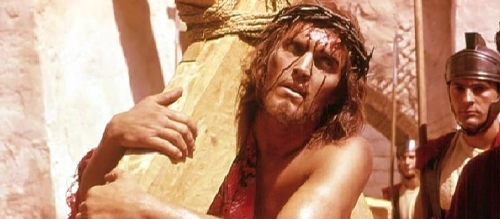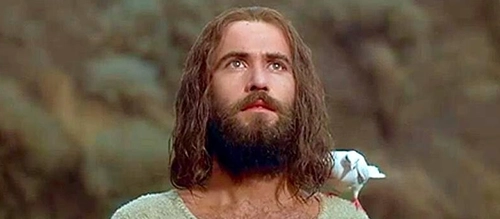5 Terrible Cinematic Depictions of Jesus Christ
It seems almost trivial to bring up the topic of religious corruption in an article regarding film, but in the countless ways that the name of Christ has been used in vain, it is through the medium of film and television that the masses are most afflicted by this sacrilege. One could probably blame the modern day cynicism regarding Christianity on the many examples of flagrant self-enrichment through Jesus’ name. Learning of the super-rich TV pastors and privately owned Christian-specific streaming sites is enough to turn anyone’s stomach sick.
As soon as movie executives realised that Christianity sold, they couldn’t take their teeth out of it; seeing Ben-Hur (1959) save its studio MGM from bankruptcy and become one of the twenty highest-grossing films of all time only fanned the flames of greed. Films that focus on the life of Jesus do have a guaranteed audience, with critics often pointing out that such films are exploiting childhood nostalgia and the tastes of the elderly. The focus on turning a profit can have many unfortunate side effects such as the sacrilegious bastardisation of Christ’s message and plain bad filmmaking. In other instances, the approach to Christ’s depiction is too inextricably linked to the time in which it was produced, ensuring that many works have become dated.
In this Movie List from The Film Magazine, some of the worst depictions of Jesus Christ committed to film have been outlined: there is focus on the actors’ depictions and consideration for when other elements of the film’s production have impacted that final performance. Additionally, the films that have been included in this list have each been released theatrically.
1. King of Kings (1961) Jeffrey Hunter

King of Kings was made in direct response to, and was hot off the heels of, Ben-Hur. MGM had found its cash cow and by God it was going to milk it.
Just like Ben-Hur, King of Kings is a remake of a silent classic based on the life of Jesus Christ. It even used the same poster style as Ben-Hur to help pull the crowds in. Unlike Ben-Hur, King of Kings actually put a face to Christ. Jeffrey Hunter’s specifically. Hunter (who famously played Captain Pike in the original ‘Star Trek’ pilot) could be credited as the first recognisable face of Christ in the 20th Century – he received fan mail up until his tragic death in 1969 from people who complimented his performance and expressed how moved they were by it.
Physically, it is very obvious why Hunter was cast in the role of Jesus. Not only was he very handsome, but the production team knew it and used it. As troubling as it is to see Christ’s body wrapped in a shroud that shows off tasteful nipples and thighs, the production styled Hunter in a look that is reminiscent of Renaissance art. Even when nailed to the cross, Hunter’s Christ strikes a resemblance to Diego Velázquez’s Christ Crucified. In some of the highlights of Hunter’s performance, it is his limpid blue doe-eyes that impress as they convey both Christ’s mercy and authority.
But looks aren’t everything. Especially as Jesus seems to be more of a substance over style guy. And, sadly, Hunter’s Christ lacks any character.
King of Kings, in an attempt to give a modern context to Christ’s story, focuses on the political background of the Gospels, namely the Roman occupation of Judea and the corruption of Palestine’s tetrarch’s, particularly Herod Antipas. Ironically, King of Kings massively succeeds as a historical epic: Hurd Hatfield is a gloriously camp Pilate whilst Frank Thring is thoroughly slimy as Herod Antipas – an incestuous plotline with his step-daughter is such a riot to watch that Jesus’ storyline is quite boring in comparison.
Even when preaching, Hunter comes across like he’s doing a sales pitch. Yes, he brings a warmth to Christ’s character, but even the off-screen Clause Heater in Ben-Hur comes across as more tender.
Sadly, King of Kings just doesn’t have a decent focus on Jesus and, in comparison to subsequent movies, Hunter doesn’t have the talent to grab our attention.
Recommended for you: Examining Controversial Depictions of Jesus Christ in Cinema
2. Jesus (1979) Brian Deacon

Jesus (1979) is widely believed to be one of the most-viewed religious films of all time. It is the most translated film today: over 1000 languages including several forms of sign language. Originally distributed by Warner Bros., this movie was effectively a grassroots project primarily financed by Campus Crusade for Christ (cru) who fundraised directly in different churches (with particularly generous donors winning the opportunity to film on location in Israel as an extra). The film was always intended as an evangelisation tool – something to be used in Sunday Schools and a tool for missionaries. It was a film production allegedly only motivated in spreading Christ’s message, so it stuck to a very straightforward adaptation of St Luke’s Gospel, but the lack of artistic direction over pure evangelisation essentially does the film a disservice. It maybe is an effective evangelising tool, but the film fails to inspire like its contemporaries (the ‘Jesus of Nazareth’ miniseries, which is considered a masterpiece, was released two years prior).
The attitude of its star Brian Deacon succinctly describes the film’s problem. In over 40 years since its release, Deacon has declined any invitation for a reunion and has openly expressed his anger at the movie’s final product when it was first released. Deacon’s performance isn’t terrible; his Christ is likeable and charismatic – straight out of the pages of a Children’s Bible. Sadly, his performance is held back by decisions made by the movie’s producers.
The source of Deacon’s resentment towards Jesus (which he considers the worst film he has ever been involved in) is the fact that he and the rest of the cast and crew filmed on location in Israel for a year capturing hours of footage. Deacon was promised a four hour epic and he got a 2 hour final feature. His anger is shared and expressed by much of his fellow cast who found themselves cut from the film or had their voices dubbed over. Unfortunately, this severe editing affects both the power of the story and Deacon’s impact in his performance.
Poor production value further negatively affected Deacon’s performance as he unfortunately contracted pneumonia during the tail-end of filming. This is seen on-screen as his portrayal becomes markedly subdued. Filming the crucifixion sequence was especially difficult for him, and he required body doubles during the long shots to give him relief.
Deacon’s approach to his performance as Christ had been done better before Jesus and has been done better after Jesus, and probably by productions that actually cared about their film’s artistic value.

